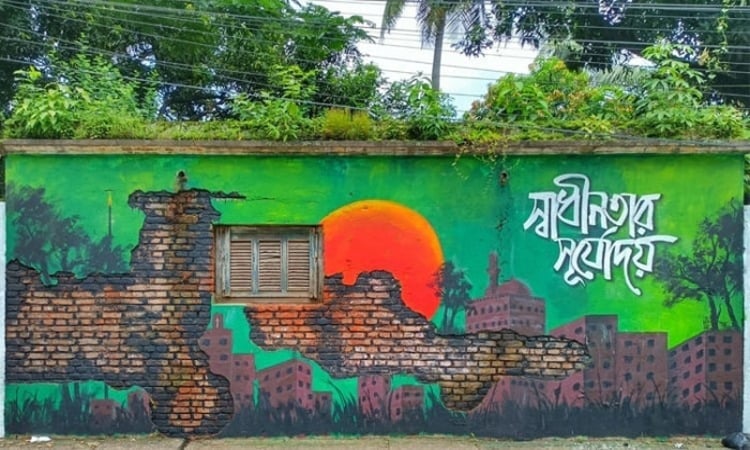By late July 2024, the streets of Dhaka no longer looked like a capital city in peace. They were wounded. Bullet casings clattered on hot asphalt, blood pooled in alleys and intersections, and police armored vehicles moved with menace. But amid the destruction and rising fear, a new form of resistance emerged — students, armed with spray paint, took to the walls.
On July 28, defiant hands painted political graffiti across Dhaka. In bold red, black, and white, the messages weren’t just slogans — they were declarations of a people reclaiming space, stories, and truth from a regime accused of brutal suppression.
This wasn’t a moment. It was the beginning of something final. The last phase of the revolution had begun.
The seeds of upheaval had been sown long before July. The Anti-Discrimination Student Movement, originally sparked by calls for equity and justice in education and society, had morphed into a nationwide demand for systemic change. The killing of student coordinator Abu Sayeed in mid-July during a peaceful protest in Rangpur ignited a fire that could no longer be contained.
In Rangpur alone, four more lives were lost on July 19, gunned down by police bullets — ordinary men who had dared to raise their voices: a goldsmith, a fruit vendor, a student, a shop worker. Their deaths shook the conscience of the country.
Faced with growing protests, the ruling Awami League scrambled for control. The government’s narrative became a mixture of defensiveness, distraction, and denial.
Awami League General Secretary Obaidul Quader, speaking at a press briefing, warned that a coup attempt — akin to Sri Lanka’s ousting of its leadership in 2022 — was being plotted.
“There was a conspiracy to seize the Gana Bhaban,” he said. “If a curfew had not been imposed, the Prime Minister’s residence might have fallen.”
Quader also lashed out at Dr. Muhammad Yunus, Nobel Laureate and long-time critic of the regime, accusing him of inciting foreign intervention. “He used to oppose in secret, now he’s doing it openly,” said Quader, referring to Yunus’s calls for free and fair elections under a neutral interim government.
Ironically, Quader’s warnings, intended as deterrence, only revealed the fragility of the regime — and the inevitability of change.
On the same day as the protests escalated, former Prime Minister Sheikh Hasina paid a visit to the Bangabandhu Sheikh Mujib Medical University (BSMMU) to meet victims of the clashes. Cameras captured her moving between beds, but the nation asked: where was her accountability?
Instead of addressing student demands, Hasina accused Jamaat-e-Islami and Shibir — long-time scapegoats — of inciting unrest.
“They are destroying our symbols of development,” she told the Spanish Ambassador in a diplomatic meeting that evening. “They are attacking what brought comfort and pride to the people.”
She also praised the army and law enforcement’s “restraint,” while revealing that 21 members of her own party had died — though she provided little context or evidence to support the claim.
In what appeared to be a desperate effort to divert public attention, ministers offered statements of clarification on unrelated matters. State Minister for Shipping Khalid Mahmud Chowdhury, in a press conference, reassured the public:
“India is involved in Mongla Port through a line of credit. That doesn’t mean India is operating it.”
It was a strange time for such an assertion — but the timing reflected the government’s unease. Rumors of foreign intervention, shifting alliances, and internal discontent were swirling in public discourse. The ruling party was increasingly seen as paranoid, disconnected, and dangerously repressive.
Yet despite the clampdowns, the curfews, the bullets — students didn’t stop. Graffiti appeared in Farmgate, in Mohammadpur, in Tejgaon — some rushed, some detailed. “Freedom can’t be killed,” “No more fake elections,” “Blood remembers,” and “Hasina Must Go” were painted in crimson and black. These weren’t merely protests — they were memorials. Murals of fallen martyrs appeared on half-shuttered shops and boundary walls, some painted overnight.
And beyond the graffiti, people began organizing in new ways. Farmers and garment workers spoke of strikes. Teachers circulated manifestos. Lawyers drafted outlines for transitional justice. Online, a generation born after 2000 was coordinating, documenting, and dreaming of a country that belonged to its people, not a dynasty.
As July came to a close, it was clear that the state’s efforts to cling to power through fear were failing. The revolution, now in full momentum, was no longer just about student grievances. It was about decades of silenced voices, rigged elections, economic inequality, and a hunger for democracy.
What happens next may be uncertain, but one truth stands unshaken: the final phase has begun — and it will be written not in state press releases, but in the streets, on walls, in hearts, and in the names of those who bled for a freer tomorrow.


